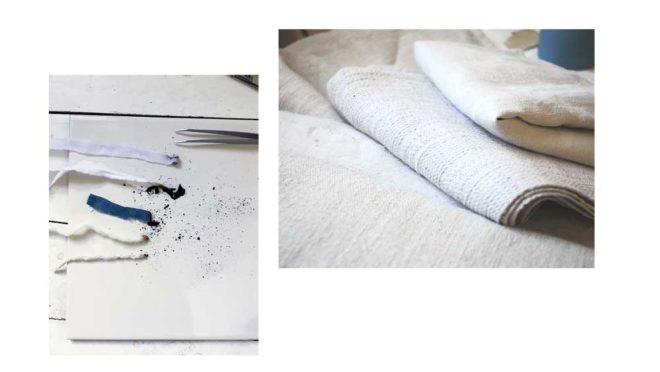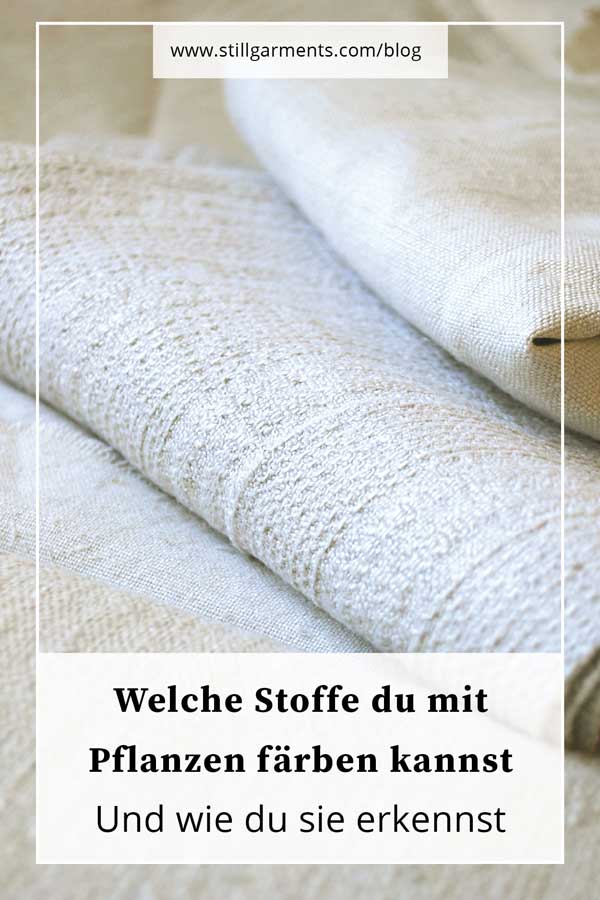Your basket is currently empty!

Plant dyeing 101: Choosing fibres to dye with plants
For dyeing with plants it's very helpful to not only know about dye plants, but also about the textiles you want to dye. Textiles, wovens or knitwear, surround us everyday. At the same time, we often don't know much about how they were made and their characteristics. While textiles are omnipresent, they're not a subject that's deemed important very often. Had I not happened to study fashion design, would I ever have learnt about the different fibres that clothe, warm, protect me? So if you feel like textiles are a bit of a mystery, then here is a brief overview for you!
When dyeing with plants, you will get the best results on fabrics made from natural fibers. This can be animal fibers such as silk, wool and other animal hair, or vegetable fibers such as cotton, linen or hemp.
You can also dye fabrics made of a mix of these natural fibers (for example a fabric made of cotton and wool) with plants. If you do, treat the textile as you would the most sensitive fiber in the mix: In the example it would be the wool, which could felt from too much heat/friction.
Do you have a fabric that contains synthetic fibers, such as polyester, in addition to natural fibers? How well it will fare in a natural dye bath, depends on how much of the synthetic component it contains. You can also dye whole items of clothing. The vast majority of these are however sewn with polyester thread - and in this case the seams take on the color only slightly or not at all.
Do you have fabrics that have been in your closet for a long time or that were given to you, and you don't even know what they are made of? Below I'll show you an easy way to find out.
Identify fibres with the burn test
Did you also have a subject in school or universtiy that in retrospect turned out to be a lot more exciting? That helps you unexpectedly in different life situations? After more than ten years: Textile science is this subject for me. I can remember it better than many things from my (fashion design) studies - I would never have believed that back then, and I didn't find it particularly exciting either.
And what's so interesting about it? I probably never used the magnifying glass for thread counting after the last exam, but I've used the burn testseveral times since then. Of course, the touch and appearance of fabrics already give clues about the composition, but the burn test reveals even more. Maybe this is an old hat for you? I had never heard of it before and I found it so very useful.
How to make a burn test
Please be careful with the burn test. Some fibres can melt and drop. Use tweezers and a fireproof surface. Cut a narrow strip of your fabric. If you suspect that the fabric is made up of different fibers, try testing them individually. To do this, you can unravel woven fabrics at the cut edge. Then you “pick” yarns from the weft and warp direction (which is parallel to the selvedge) and use them for the burn test.
In the video the order is from top to bottom: mix cotton-synthetic; Cotton; Silk; Wool; Mix of wool and synthetic.
If you look closely, you can already see some differences between the fibers - you should pay attention to the following in a burn test:
- Is the substance highly flammable? How does the flame behave: lively, flickering, or does it go out quickly? Is it light, rather dark, bluish?
- What does the smoke smell like?
- What does the ash or residue look like? If a solid residue remains, can you crush it between your fingers?
Cotton, linen, hemp: If you take a closer look at fabrics made from these vegetable fibers, cotton threadss are usually smoother / more regular than the others. However, they cannot be distinguished so well by their burning behavior. Cotton burns quickly and with a bright flame, it continues to glow and is easy to blow out. The smoke smells like burning paper, the ash looks similar and is very fine.
Wool: The flame goes out quickly, compared to cotton it is more subdued. The smoke smells like burned hair. A blistered, black residue remains, but it is easy to crumble.
Silk: Flame, odor, residue are similar to wool - but can usually be easily distinguished from wool visually and by the touch.
Blends of natural and synthetic fibers
In the video I show two mixed fibers that we often come across in everyday life.
Cotton and polyester: The fabric burns quickly and brightly, produces soot and melts in the form of drops. The smoke doesn't smell of paper, but of burnt plastic. A shiny, black residue remains that cannot be rubbed on. (Do not touch it until it has cooled down!)
Wool and polyester: This knitting yarn could be mistaken for pure wool. The difference becomes visible in the burn test. The flame burns bright and lively. There is a slight smell of burned hair, but also the aromatic smell of plastic. The residue cannot be completely crumbled.
Interestingly, the German wikipedia has a complete article with descriptions of a number of different fibres and how to identify them with the burn test that does not exist in the English version. So maybe my love for the burn test is very German?
Tencel, Modal, Viscose - synthetic fibers made from natural raw materials
There are also synthetic cellulose fibers, which at first glance seem a little confusing: for example Tencel, Modal, Viscose. They are manufactured synthetically, but made from the same raw material as natural plant fibers, cellulose. If you want to read more about the production and sustainability of these fibers, this gives you an introduction to Tencel .
I dyed different samples of all of these fabrics. Not all fabrics have accepted the colors equally well. I suspect the differences have to do with the finishing of the fiber or the textile construction. But basically you can also dye these fabrics with plants!
And can you dye jersey with plants?
That's a common question in my workshops, and the answer is, yes! Whether your fabric is woven or knitted like jersey is not that important. What is important, so to speak, is the content, the fiber composition. Jersey is sometimes used almost synonymously for elastic synthetic mix fabrics. Jersey, as a knitted fabric, is already elastic due to its textile construction, even if it is made of pure cotton. If you look closely at Jersey, you can see that it's made of tiny stitches the same shape as in a knitted hat, only much smaller, and that's what makes it elastic.

Über das Beizen, und warum es wichtig ist für’s Färben mit Pflanzen, kannst du hier mehr lesen:
Comments
2 responses to “Plant dyeing 101: Choosing fibres to dye with plants”
-
Hallo liebe Elke,
ich nahm schon mal an deinem Workshop teil, danke dir dafür.
Ich baschäftige mich gerade mit natürlichen Duftstoffen für Textilien.
Hast du damit Erfahrung und Tipps?
Für eine Antwort wäre ich dir sehr dankbar.Herzliche Grüße,
Anastasia-
Hallo Anastasia,
zu dem Thema kann ich dir leider nicht viel sagen – außer dass ich glaube, dass es in dem Buch ‚A weaver’s garden‘ von Rita Buchanan auch ein Kapitel über Duftpflanzen gibt. Wenn ich das nicht verwechsle. Vielleicht wirst du da fündig!
Liebe Grüße!
-

Leave a Reply